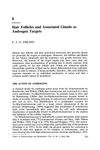TLDR Testosterone, DHT, and estradiol significantly affect hair cell growth.
The study investigated the effects of testosterone, dihydrotestosterone (DHT), and estradiol on the growth of human hair outer root sheath keratinocytes in vitro. The research aimed to understand how these hormones influenced hair growth at the cellular level. The findings suggested that these hormones played a significant role in regulating the growth of keratinocytes, which are crucial for hair development. The study provided insights into the hormonal regulation of hair growth, which could have implications for understanding conditions like androgenetic alopecia. However, the document did not specify the number of participants or detailed experimental results.
22 citations
,
July 1990 in “Acta Dermato Venereologica” High levels of testosterone and dihydrotestosterone inhibit hair cell growth, while high levels of estradiol promote it.
 51 citations
,
January 1989 in “Journal of Investigative Dermatology”
51 citations
,
January 1989 in “Journal of Investigative Dermatology” Men with male-pattern baldness have more androgen receptors in their scalp's oil glands, which may contribute to hair loss.
25 citations
,
January 1988 in “Journal of Investigative Dermatology” 28 citations
,
November 1987 in “Journal of the American Academy of Dermatology” The model successfully grew and differentiated hair follicle cells in the lab.
135 citations
,
November 1987 in “Differentiation” Outer root sheath cells consistently express certain keratins influenced by their environment.
39 citations
,
July 1987 in “Journal of Investigative Dermatology”  53 citations
,
May 1986 in “Clinics in endocrinology and metabolism”
53 citations
,
May 1986 in “Clinics in endocrinology and metabolism” Androgens like testosterone affect hair growth and oil production differently across body parts and individuals.
 August 2014 in “Journal of clinical & experimental dermatology research”
August 2014 in “Journal of clinical & experimental dermatology research” Platelet-released growth factors can treat hair loss by activating hair follicle stem cells, blocking certain pathways, and controlling inflammation and fibrosis.
10 citations
,
October 2000 in “PubMed” E6/E7 oncogenes in hair follicles cause continuous hair growth by skipping the resting phase.
 94 citations
,
February 1994 in “The journal of investigative dermatology/Journal of investigative dermatology”
94 citations
,
February 1994 in “The journal of investigative dermatology/Journal of investigative dermatology” EGF makes hair follicles grow longer but stops hair production.
59 citations
,
August 1981 in “PubMed” Trichilemmal keratinization is a unique process in hair follicles where the outer root sheath turns into keratin without a specific layer.



